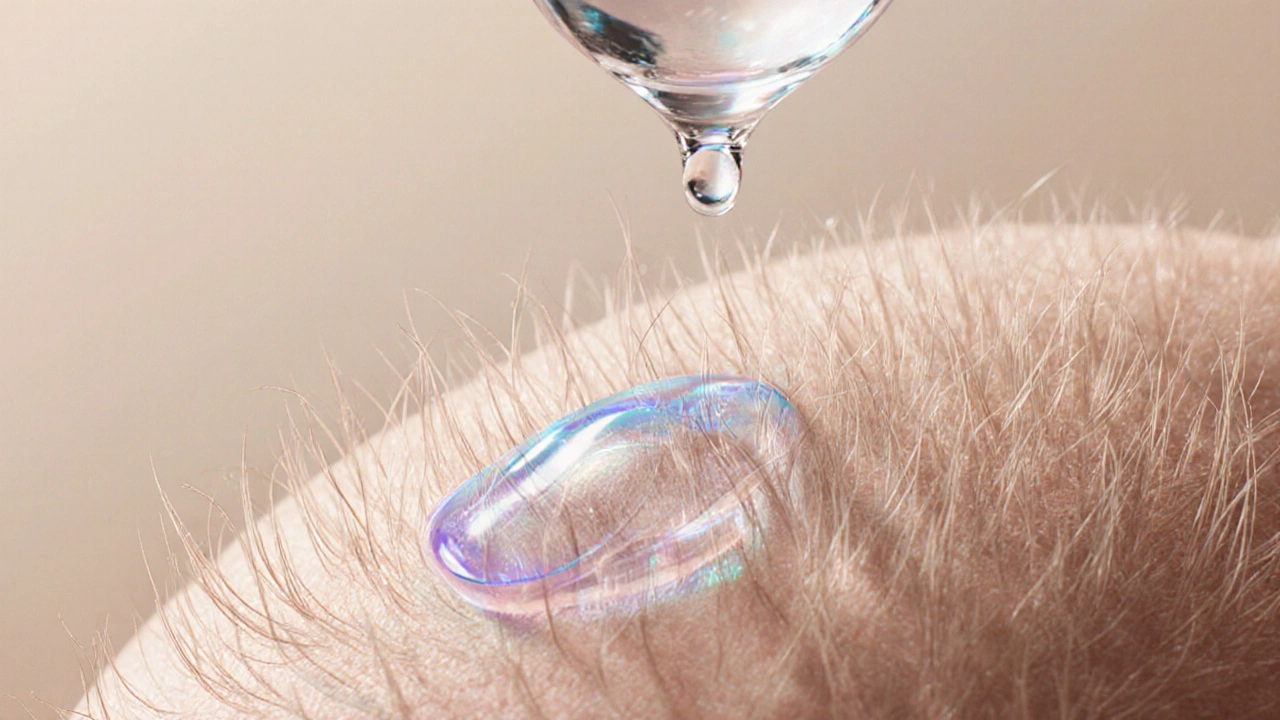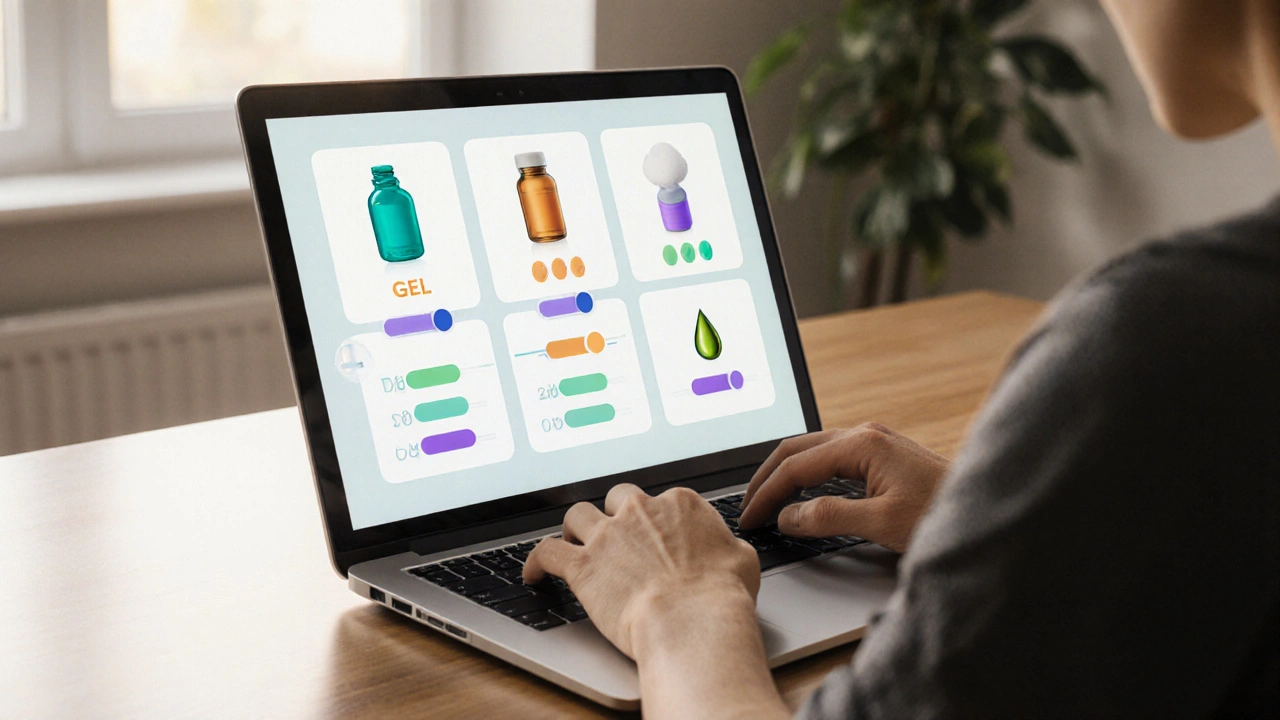Tugain vs. Alternatives: Decision Matrix
| Product | Delivery | Cost | Side Effects | Convenience | Score |
|---|
Key Takeaways
- Both Tugain Solution and its US‑market counterpart Rogaine deliver 5% minoxidil directly to the scalp.
- Generic options like Kirkland Minoxidil cost far less but may lack the extra moisturizing base that Tugain offers.
- Oral finasteride works on a different hormone pathway; it’s useful when minoxidil alone stalls.
- Natural oils (peppermint, rosemary) and low‑level laser devices provide modest gains with minimal side‑effects.
- Choosing the right product hinges on concentration, application frequency, budget, and your tolerance for scalp irritation.
Hair thinning is a daily worry for millions of Australians. The market is crowded with sprays, foams, pills, and even devices that promise thicker strands. If you’ve heard about Tugain Solution is a topical minoxidil formulation (5% concentration) that combines the active vasodilator with a soothing carrier base to reduce scalp dryness, you’re probably wondering how it stacks up against the other choices out there. This guide breaks down the science, the price tags, and the real‑world performance of Tugain and six common alternatives so you can decide what fits your routine and budget.
How Tugain Solution Works
Minoxidil was first approved by the FDA in 1988 as a blood‑pressure medication. Researchers later discovered that when applied to the scalp it opens potassium channels, boosts blood flow, and prolongs the anagen (growth) phase of hair follicles. Tugain grabs the same 5% minoxidil ingredient but hides it in a gel‑like carrier that contains panthenol (pro‑vitamin B5) and glycerin. Those additives keep the scalp hydrated, which many users report reduces the itching and flaking that can accompany generic minoxidil.
Typical usage is twice daily, applying 1mL to the affected area and allowing it to dry before styling. Clinical studies in Australia show an average hair‑count increase of 12-15% after six months of consistent use, matching the results seen with other 5% products.
Overview of Popular Alternatives
Below is a quick snapshot of the main competitors you’ll encounter when browsing online pharmacies or local pharmacies in Sydney.
- Rogaine is the original brand‑name minoxidil, sold in foam or liquid form across Australia.
- Kirkland Minoxidil is a 5% generic solution that mirrors the active ingredient but skips the added moisturizers.
- Finasteride (branded as Propecia) is an oral 1mg tablet that blocks the conversion of testosterone to dihydrotestosterone (DHT).
- Peppermint Oil is a natural essential oil, often diluted in a carrier oil, that has shown modest hair‑growth stimulation in animal models.
- Low‑Level Laser Therapy (LLLT) devices emit red light wavelengths (650‑660nm) that are believed to improve cellular metabolism in follicles.
- Platelet‑Rich Plasma (PRP) Therapy involves drawing a small amount of the patient’s blood, concentrating platelets, and injecting them into the scalp.
- Ketoconazole Shampoo is an antifungal rinse that also reduces scalp inflammation and DHT levels locally.
Side‑by‑Side Comparison
| Product | Active Ingredient | Formulation | FDA / TGA Status | Typical Monthly Cost (AUD) | Common Side‑effects | Best For |
|---|---|---|---|---|---|---|
| Tugain Solution | 5% Minoxidil | Gel‑based liquid | Registered with TGA | $45‑$55 | Mild itching, dryness (reduced by base) | Users who want a moisturizing minoxidil |
| Rogaine Foam | 5% Minoxidil | Foam | Approved TGA | $65‑$75 | Scalp irritation, dryness | Those who prefer a quick‑drying foam |
| Kirkland Minoxidil | 5% Minoxidil | Liquid | Unregistered (imported) | $25‑$30 | Dryness, occasional dermatitis | Budget‑conscious users |
| Finasteride 1mg | Finasteride | Oral tablet | Prescription only, TGA‑listed | $30‑$45 | Sexual dysfunction, low libido (rare) | Men with progressive male‑pattern baldness |
| Peppermint Oil (2% solution) | Peppermint essential oil | Topical oil blend | Cosmetic product | $15‑$20 | Sensitisation if undiluted | Users seeking a natural, low‑risk option |
Decision Criteria: What Matters Most?
When you line up the options, ask yourself these four questions:
- Concentration & delivery: Is a 5% minoxidil necessary, or would a 2% version suffice? Foam dries faster but can be harder to target precise areas.
- Cost per month: Remember to factor in the long‑term commitment. A $50 product that works in three months may be cheaper than a $20 product that takes a year.
- Side‑effect tolerance: Scalp irritation is common with minoxidil; oral finasteride carries systemic risks. Natural oils have a lower side‑effect profile but also lower efficacy.
- Convenience: Do you mind applying twice daily? A once‑daily laser cap might suit busy professionals better.

How to Use Tugain Solution Correctly
Even the best product can flop if you don’t apply it right. Follow these steps:
- Wash your scalp with a gentle shampoo and pat dry. Residual water dilutes the solution.
- Measure exactly 1mL using the dropper that comes with the bottle.
- Apply the liquid to the thinning zones, massaging gently for 30seconds to improve absorption.
- Allow the area to dry completely (about 5‑10minutes) before styling or using other products.
- Repeat the process in the evening for a total of two applications per day.
Consistency is key: clinical data shows measurable gains only after at least 12weeks of daily use. If you miss a dose, apply it as soon as you remember, but never double‑up.
Cost Breakdown and Value Assessment
Below is a simple cost‑per‑hair‑growth‑month model based on average results from a 2024 Australian dermatology study (average increase of 13% hair count after six months).
- Tugain Solution: $50/month → $300 for six‑month trial → roughly $23 per percent increase.
- Rogaine Foam: $70/month → $420 for six months → $32 per percent increase.
- Kirkland Minoxidil: $30/month → $180 for six months → $14 per percent increase (no added moisturiser).
- Finasteride: $40/month (prescription) → $240 for six months → $18 per percent increase (systemic action, often used alongside minoxidil).
- Peppermint Oil: $18/month → $108 for six months → $8 per percent increase (but only ~6% average growth).
When you add the comfort factor-reduced scalp dryness with Tugain-the price premium may feel worth it for many users.
Potential Pitfalls & How to Avoid Them
Even with a solid plan, a few common mistakes can sabotage progress:
- Skipping the dry‑time: Applying hair products over a wet scalp washes away minoxidil.
- Using the wrong concentration: 2% versions are mainly for women; men typically need the stronger 5%.
- Ignoring scalp health: A flaky or inflamed scalp reduces absorption; treat dandruff first with a medicated shampoo.
- Expecting instant results: Hair cycles are slow; visible thickening usually appears after 4‑6months.
FAQs
Frequently Asked Questions
Can I use Tugain and Rogaine together?
No. Both contain the same 5% minoxidil, so stacking them just doubles the dose and raises irritation risk without extra benefit.
Is Tugain safe for women?
Women can use the 2% version of Tugain (if available) but the 5% formula may cause excessive hair growth on the face. Always consult a dermatologist first.
How long before I see results?
Most users notice reduced shedding after 8‑12weeks and visible thickening after 4‑6months of twice‑daily use.
What’s the difference between a foam and a liquid minoxidil?
Foam dries faster and is less messy, but the liquid (like Tugain) can spread more evenly across a larger scalp area and often includes added moisturisers.
Can I switch from finasteride to Tugain?
Yes, but you’ll lose the systemic DHT‑blocking effect. Many doctors recommend using both together for a combined approach.
Next Steps
If you’re ready to try Tugain, start by ordering a 30‑day starter kit from a reputable Australian online pharmacy. Pair it with a gentle anti‑dandruff shampoo (e.g., ketoconazole 1%) to keep the scalp healthy. Track progress with weekly photos-you’ll be surprised how small changes add up.
Still undecided? Use the comparison table to rank each attribute by personal priority, then calculate a simple score: (Weight×Rating). The highest‑scoring product is your logical pick.
Hair loss can feel personal, but the science behind these treatments is straightforward. Armed with clear data, you can move from guesswork to a plan that actually works for you.

